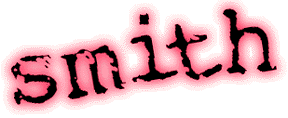
Comment on Smith's poetry...
· next Magazine Article
e mail smith at smithcrimes @-sign yahoo dot com

|
Censorship Charges Mar Tri-C West Show by Helen Cullinan The Cleveland Plain Dealer May 11, 1986 Removal of three artworks from a show in Gallery West of Cuyahoga Community College has raised complaints of censorship of controversial material on the Parma campus. The incident centered around the removal from a show of three manipulated multiframe Polaroid compositions by Cleveland artist Steven B. Smith on May 1, which was Parents' Day at the school. The compositions combined cruciform symbols, genitalia and the American flag. Some students objected, and Tri-C West provost Ronald Sobel concurred with the school's deans of humanities and instruction in having the works removed before the opening reception. A rapid-fire sequence of events culminated in what one observer described as "the best happening I've seen in years" at the opening that night. Many people who were present didn't know what was going on in the confusion; reports vastly differed. According to both Smith and gallery co-director David Vargo , Smith agreed to the removal of the disputed works but insisted on a notification of censorship in their place. When these were removed by a school official, Smith said he wrote "censored" in the blanks on the wall with a ball point pen. Several poets were scheduled to read at the opening, but a school official reassigned them to a small, remote conference room, lest they misbehave. (One of them, Robert Ritchie, had caused a scene by appearing nearly nude at a reading at the Justice Center on Feb 14, but had promised Vargo he would not cause a disturbance at Tri-C.) Poet Daniel Thompson appeared at the gallery anyway, with a portable lectern and a book, and proceeded to mouth the words in support of his censored fellow artist. According to all reports, gallery co-director Carol Demiray appeared on the spot, sandpaper in hand, and noisily sanded the "censored" writing off the wall while Thompson silently read. From a happening aspect, the timing was perfect, said a faculty member. The administration and many of the students didn't think it was funny. Provost Sobel was critical of Vargo for not putting together an "appropriate" show, and for letting things get out of hand. Vargo agreed that the community and college atmosphere present special problems with such a show. Reaction to Smith's work and the opening night snafu were mixed. Detractors objected heatedly to the content of the photos, while Smith's supporter tended to defend his right to free speech more than they defended the art itself. Smith said one student accused him of devil worship, which he categorically denies. Another suggested he take his art to Russia. Another called his work "totally disgraceful, disgusting, tasteless, cheap." Supporters told him, "I can't believe that they would censor anything on the college level. Maybe we'll have to start bringing notes from Mommy and Daddy next," and "Do they censor books and classwork the same way? We are not being educated but subjected to their opinion." A faculty member who asked not to be identified said, "It would be difficult to fight (for the censored work) on the basis of aesthetics, but once it was up, quite a few of us saw it as an educational opportunity and it should be discussed for what it was." At a previously scheduled faculty meeting the following day, Sobel said the incident was discussed at length. "There were people who felt that art that is dispersed in a college community must be suitable - that is the word we are using - and others felt that we should be the opposite of that," he said. "It was a sharing of differences of opinion on what might be regarded as a no-win situation." Smith maintains that "They arbitrarily broke their agreements with us; they misled us; they did not bother to tell us about moving the poets, and ultimately they engaged in the equivalent of book burning; they as a supposed institute of higher education unilaterally engaged in acts of art censorship as well as violations of the poets' and artists' rights of free speech." Smith also points out that the censored Tri-C works previously were exhibited in the "People's Art" shows at the Cleveland State University Art Gallery (where one was popularly voted "the most imaginative use of materials" in 1984 and another was voted "the most outrageous" in 1985) and also in the "Worker's Art" show last fall. Smith's work did not go unnoticed. Plain Dealer columnist James Neff quoted a mildly shocked student reaction ("Oh my God, it's disgusting. But, hey, it's art") to the 1984 People's Show at CSU. My own review of a 1984 three-person show at Spaces that included Smith was headlined "Art gallery plugged into shock." There he did not show the Polaroids but found object collage reliefs (such as remain at Tri-C West) that contained morbid elements but were effective as catalysts of thought. The students who objected to Smith's work at Cleveland State University drew no reaction from the administration. "We've never been censored," said CSU art chair Walter Leedy. "It's more a problem of self-censorship. We pick and choose according to our own value system. But we are aware of the obligation to expand boundaries and help to redefine ideas, the same as in science and research. That is what a university is for." The Tri-C West show, on view through May 23, includes other work by Smith, as well as by Frank Fleming, Melissa J. Craig, Amy Sparks and guest curator S. Judson Wilcox. Gallery hours are 8 a.m. to 9 p.m. Monday through Thursday, 8 a.m. to 5 p.m. Friday, and 9 a.m. to noon Saturday. The address is 11000 Pleasant Valley Rd., Parma. |

Comment on Smith's poetry...
· next Magazine Article
e mail smith at smithcrimes @-sign yahoo dot com